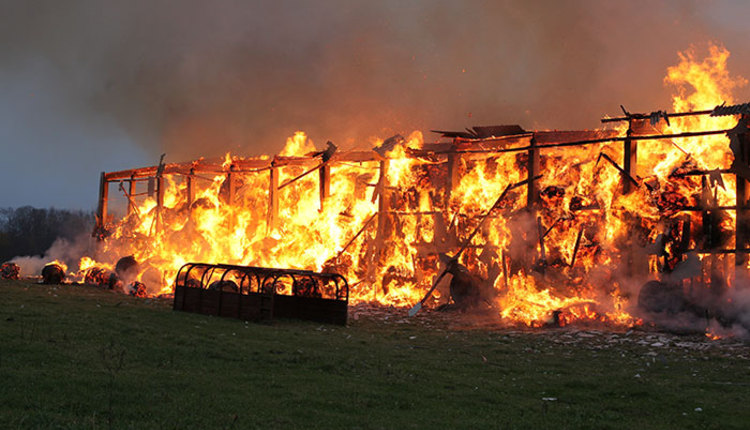
Moisture is often used to combat fire, not ignite it. The latter is true for hay and straw, though, in barns housing bales with high moisture levels.
When hay is baled at more than 20% moisture, thermophilic bacteria can take over and cause temperatures to rise. Moist bales can spontaneously combust and result in fire, especially if temperatures surpass 175°F.
Extension specialists with The Ohio State University say most hay fires occur within the first six weeks after baling. Initial fire prevention starts by keeping moist bales outside or in a well-ventilated area to allow heat and moisture to escape.
Consider potential wet spots in a field and the moisture level of the hay at the time of harvest to assess fire risk. If there is concern, monitor hay twice a day over a six-week period, or until temperatures stabilize.
One way to take temperatures is by inserting a long probe thermometer into the center of a bale or stack. If this tool is not available, there are makeshift alternatives for checking hay temperature as well.
Using a 3/4-inch pipe with ends closed to a point and 3/16-inch holes drilled in the bottom is one option extension specialists offer. Lower a thermometer on a string into the pipe and leave it in the bale or stack for 15 minutes to get an accurate reading.
Inserting a 3/8-inch pipe into the center of the bale or stack and using personal judgement to determine the temperature will work, too. If the pipe is too hot to handle, odds are the hay is at risk of ignition.
There is a possibility of hot hay creating cavity burns within a stack. Take caution when acquiring temperatures to avoid falling into a hollow area. The extension specialists recommend having someone nearby, using planks to spread out weight, and even putting on a harness to ensure safety while checking stacks.
No action is needed if the hay temperature is less than 120°F. Temperatures between 120°F and 130°F can encourage mold growth, which makes protein in the hay less available to animals. These temperatures are too low to start a fire, but a surplus of mold will begin to hike up the heat.
Hay enters the danger zone at about 150°F. At this point, begin checking temperatures twice a day and unstack hay to promote air circulation.
At 160°F to 170°F, there is cause for alarm. Chemical reactions within the hay will occur and temperatures will continue to climb. Unstacking hay at this time should only take place when the fire department is present.
If hay reaches 175°F or higher, call the fire department immediately. Remove any machinery or livestock from the barn first, then remove hot hay with the assistance of the fire service. Be prepared for a fire to occur and keep tractors wetted down if they are in contact with the hay.
Critical temperatures and actions to take
Temperatures (°F) | Condition and action |
125°F | No action needed. |
150°F | Hay is entering the danger zone. Check twice daily. Disassemble stacked hay bales to promote air circulation to cool the hay outside. |
160°F | Hay has reached the danger zone. Check hay temperature every couple of hours. Disassemble stacked hay to promote air circulation to cool hay; have fire department present while unstacking from here on. |
175°F | Hot pockets are likely. Alert fire service to possible hay fire incident. Close barns tightly to eliminate oxygen. |
190°F | With the assistance of the fire service, remove hot hay. Be aware the bales may burst into flames, so keep tractors wet. |
200°F + | With the assistance of the fire service, remove hot hay. Most likely, a fire will occur. Keep tractors wet and fire hose lines charged in the barn and along the route of where bales are to be stacked. |

Amber Friedrichsen is serving as the 2021 Hay & Forage Grower editorial intern. She currently attends Iowa State University where she is majoring in agriculture and life sciences education-communications with a minor in agronomy. Friedrichsen grew up on her family’s diversified crop and livestock farm near Clinton, Iowa.

